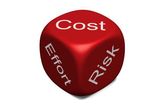
The Environmental Defense Fund’s Investor Confidence Project (ICP) attempts to reduce uncertainty and risk by providing a comprehensive framework that defines specific required elements, procedures and documentation pertaining to each critical component involved in an energy efficiency project, as well as a third party quality assurance review system. The ICP addresses the entire energy efficiency project development process, specifying in detail the required components to help reduce risk and promote a successful, long-lasting project outcome.
While the ICP works toward reducing uncertainty and associated risk, there will still be uncertainty inherent in any project. The question then usually asked is “How much uncertainty, and what risk?”
There are volumes of resources available regarding quantifying uncertainty. However, the problem lies in practicality. While uncertainty can be quantified, the process of doing so often becomes a large mathematical exercise that is an expensive effort most energy efficiency projects simply cannot afford to include.
But is quantifying uncertainty critical? Isn’t there uncertainty in the uncertainty estimates themselves? And what value does quoting levels of precision and confidences to an investor really have?
It can be argued that attempting to quantify uncertainty (as part of a measurement and verification effort or some other process related to an energy efficiency project) is costly and perhaps unnecessary. Rather, the real value may lie in simply identifying the areas of uncertainty, qualifying their associated risk, and then developing methods to address these areas to reduce the uncertainty associated with them.
Reducing uncertainty depends on the areas of concern, but usually involves collecting additional data so that informed inputs and assumptions can be introduced into the project. Additionally, some areas of potential uncertainty, for example modeling inputs, may be more quantifiable, while other uncertainties related to say occupancy or the cost of energy might be much harder to accurately quantify.
The costs of additional data and the level of rigor associated with capturing these data need to be weighed against the associated risk. But this process can be affected in a much more budget-conscious manner than quantifying the uncertainty involved, and is money better spent - on reducing the uncertainty and risk, rather than quantifying it.
All of this said, uncertainty calculations may be warranted for items such as the underwriting process, even if they cannot be necessarily justified as a part of the standard project development. To this end, there are tools available that can help automate some of this analysis, helping make this quantification process more economical.
The Investor Confidence Project, and our many active stakeholders are actively discussing these tradeoffs in an effort to find a middle ground that can bring comfort and confidence to investors, while not burdening projects with extra overhead.
If you have an opinion, please feel free to contact us directly or comment on this blog post.

Tracy is a Certified Energy Manager who holds an MS in Physics from Stevens Institute of Technology, in Hoboken, New Jersey. He has worked as an energy consultant for over 16 years. His areas of expertise include investment-grade energy audits, building performance analysis and diagnostics, and measurement and verification. Tracy manages and provides energy consulting services for a host of project types, including development and analysis services related to energy efficiency projects, commissioning, re- and retrocommissioning, LEED certification support services, energy modeling and measurement and verification. He currently serves as a member of the IPMVP technical advisory committee, as well as his local town’s Sustainable Energy Committee.

 RSS Feed
RSS Feed